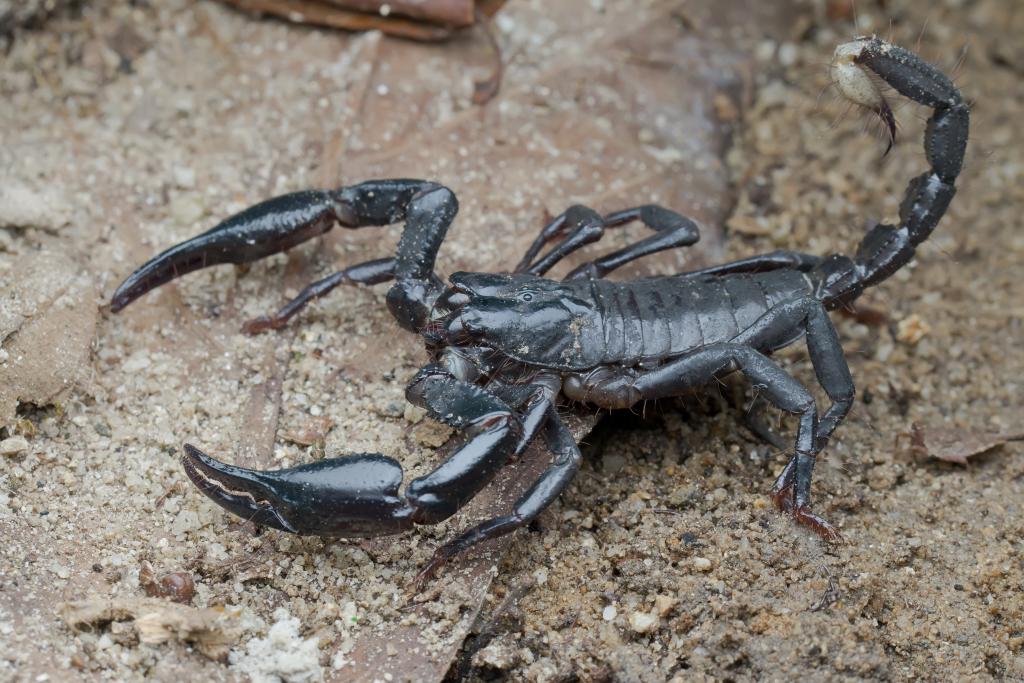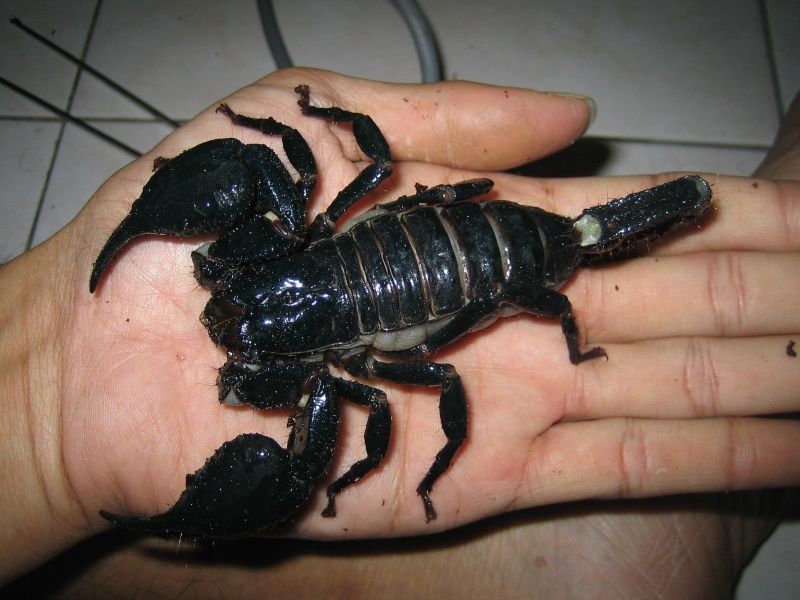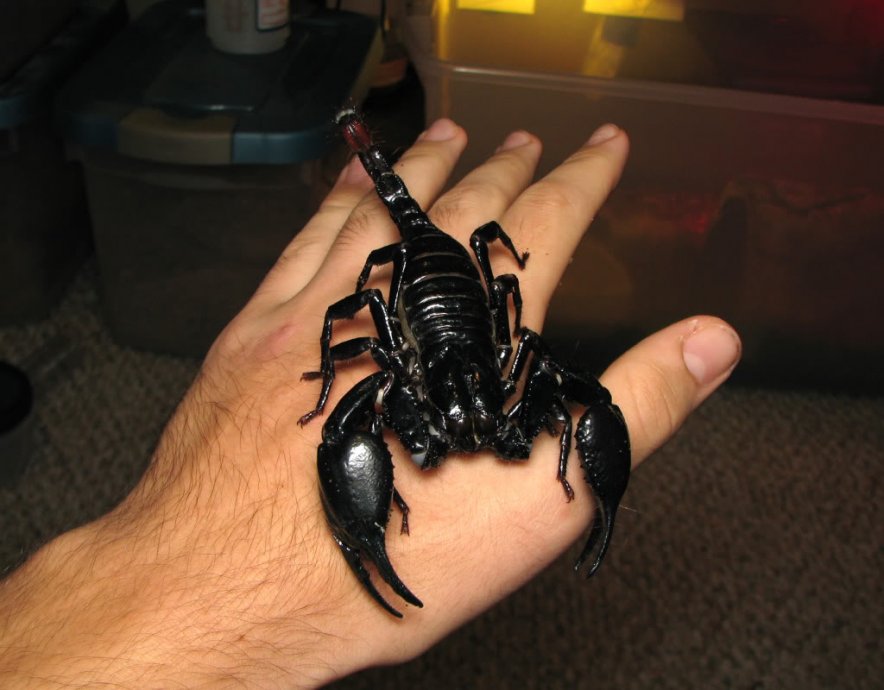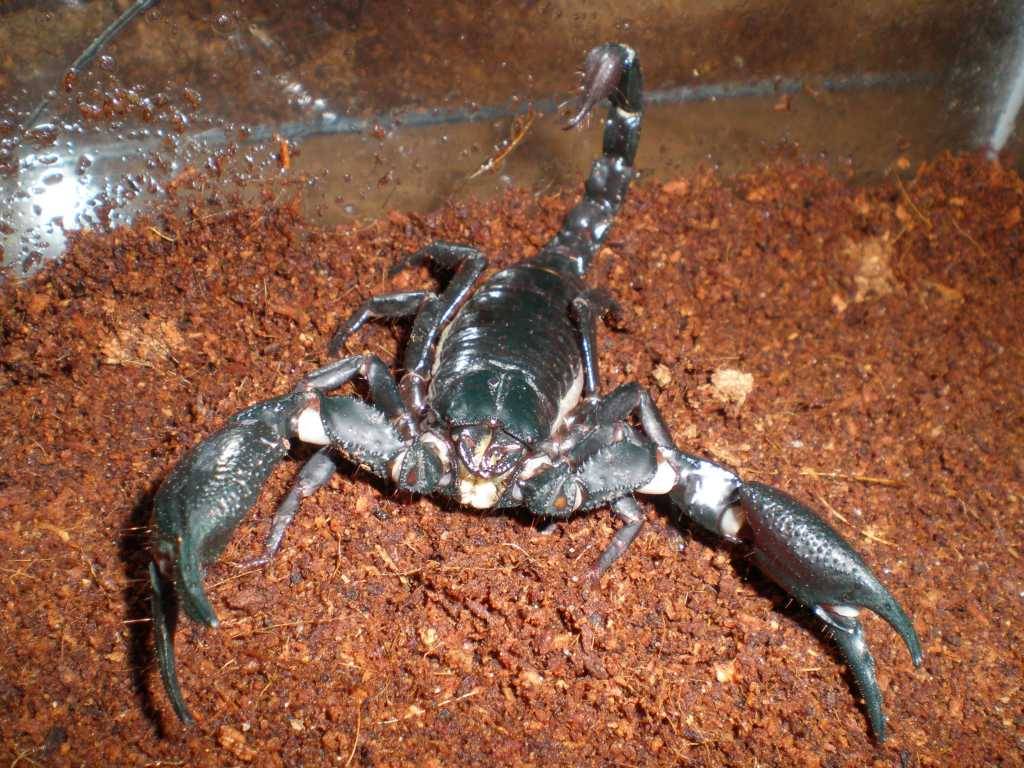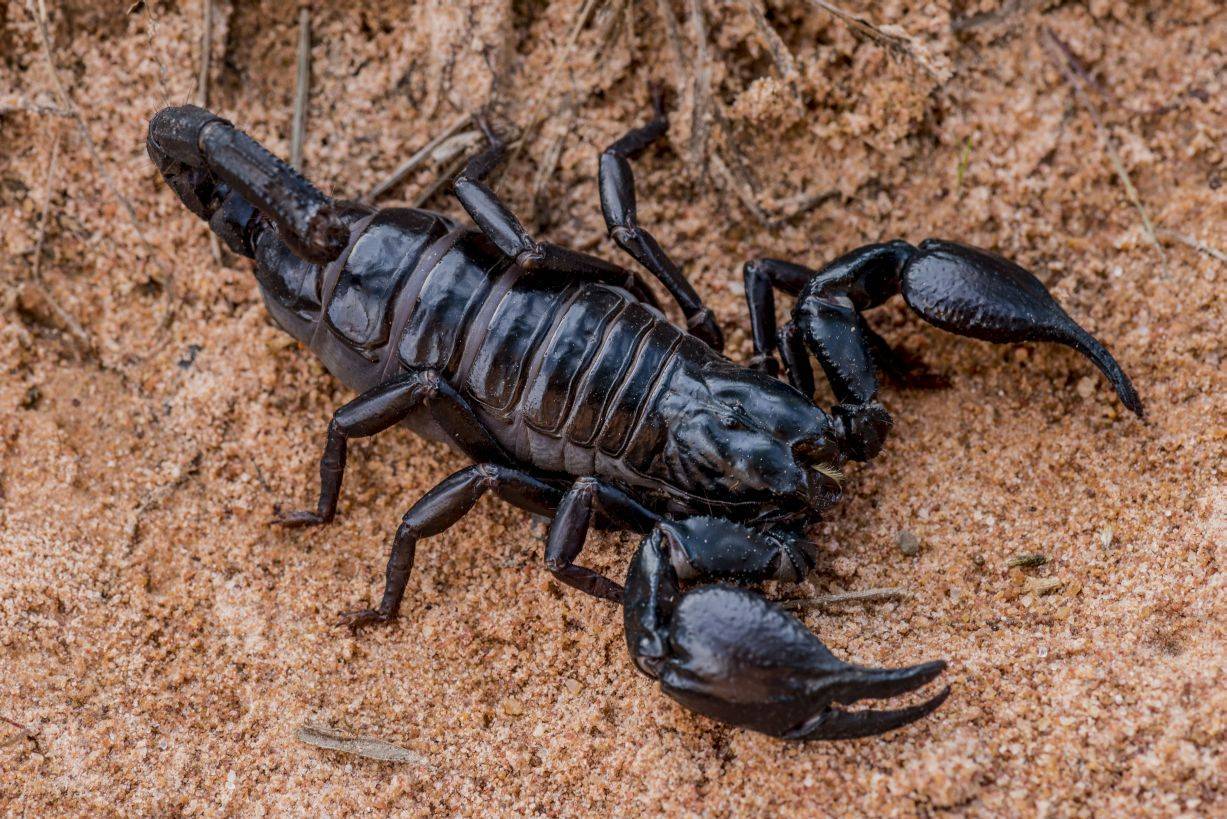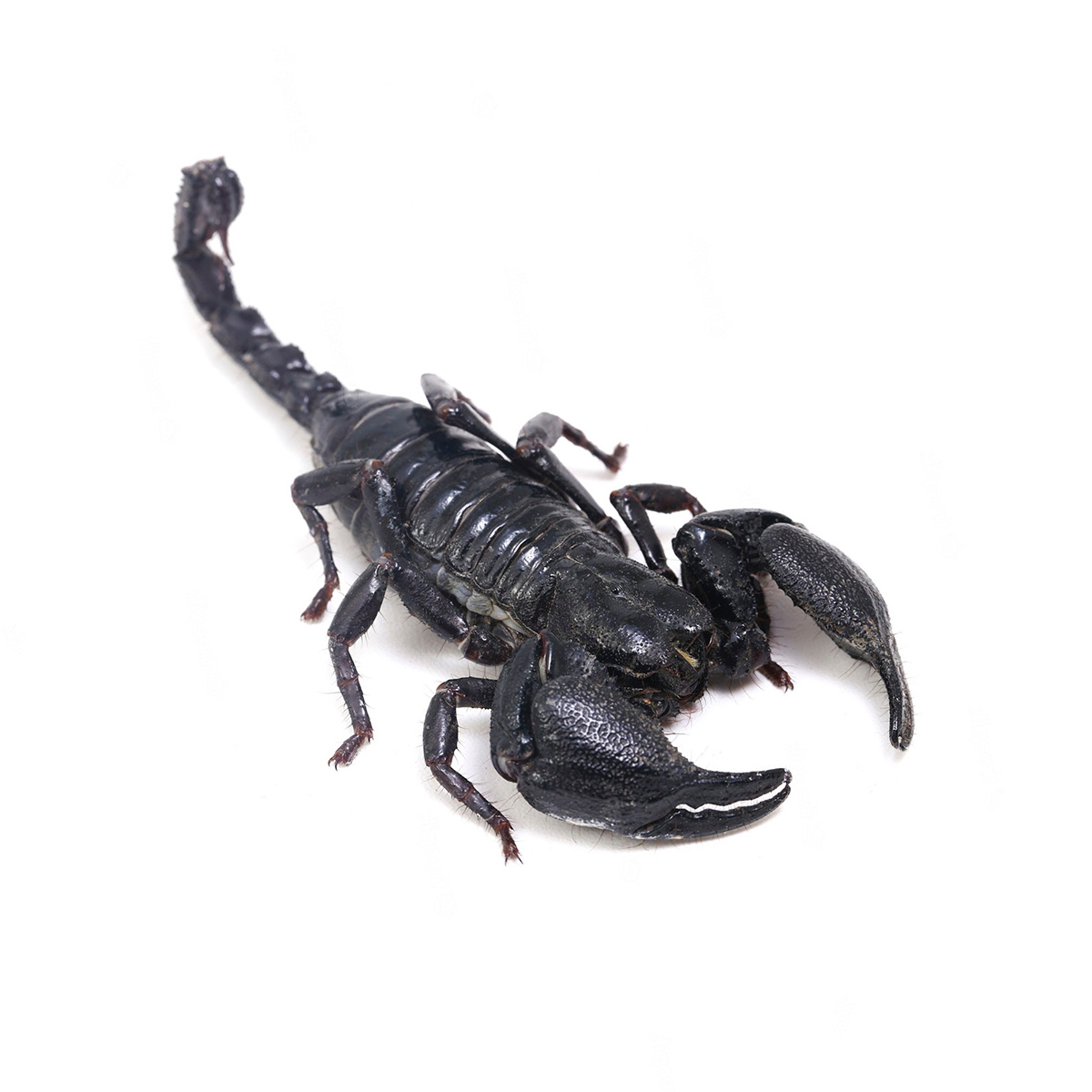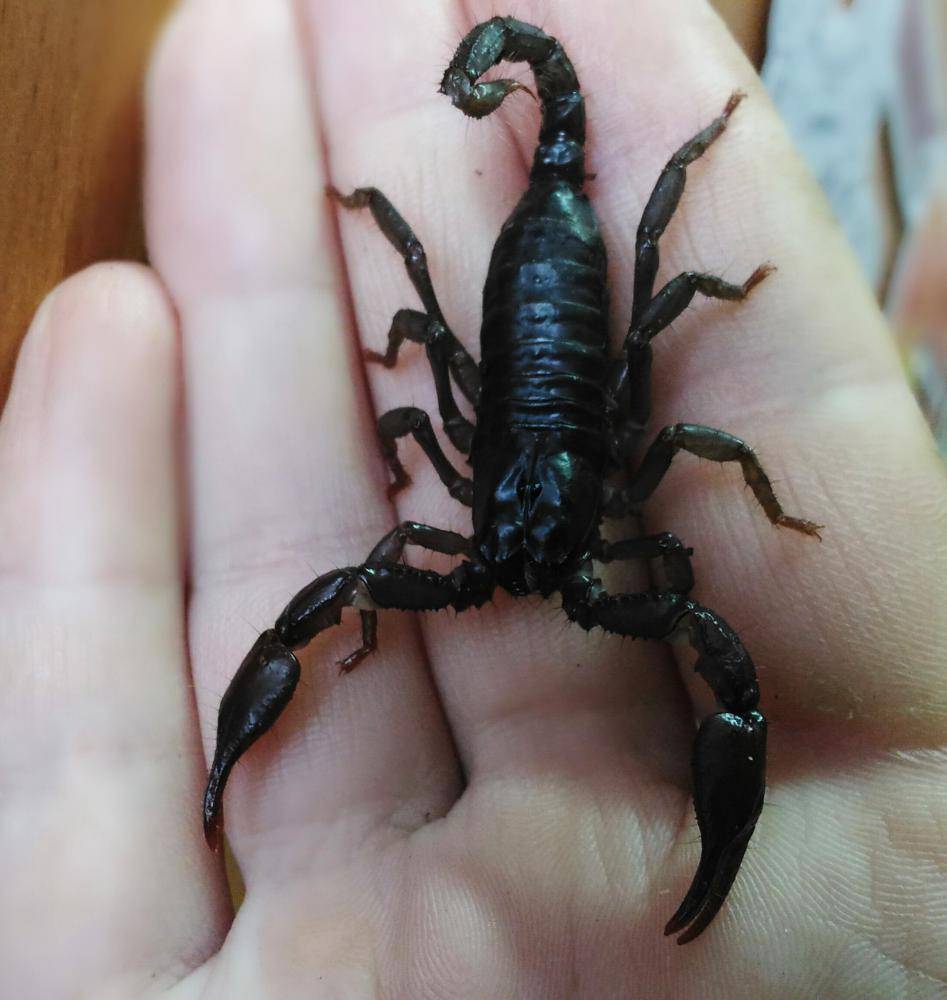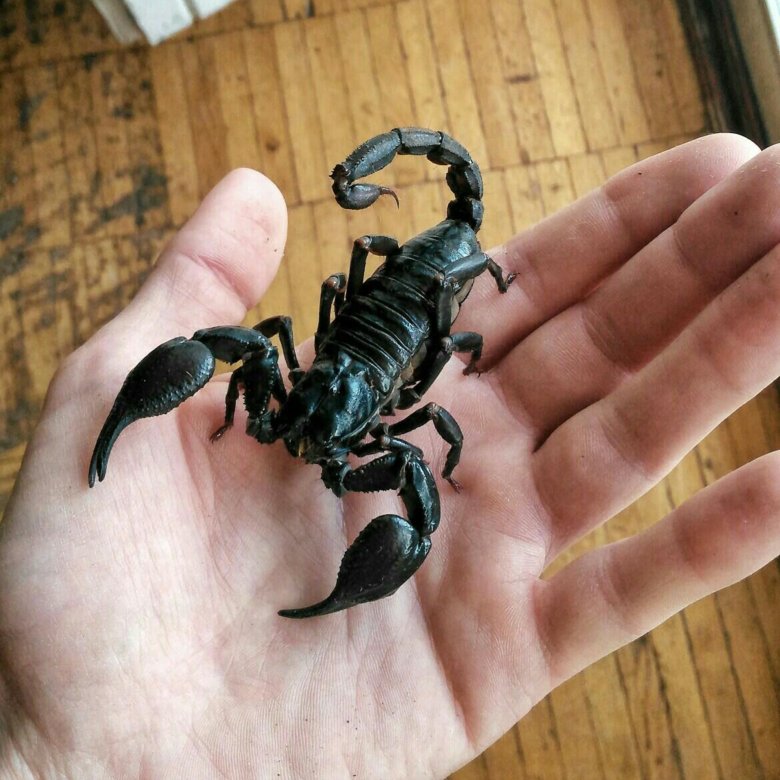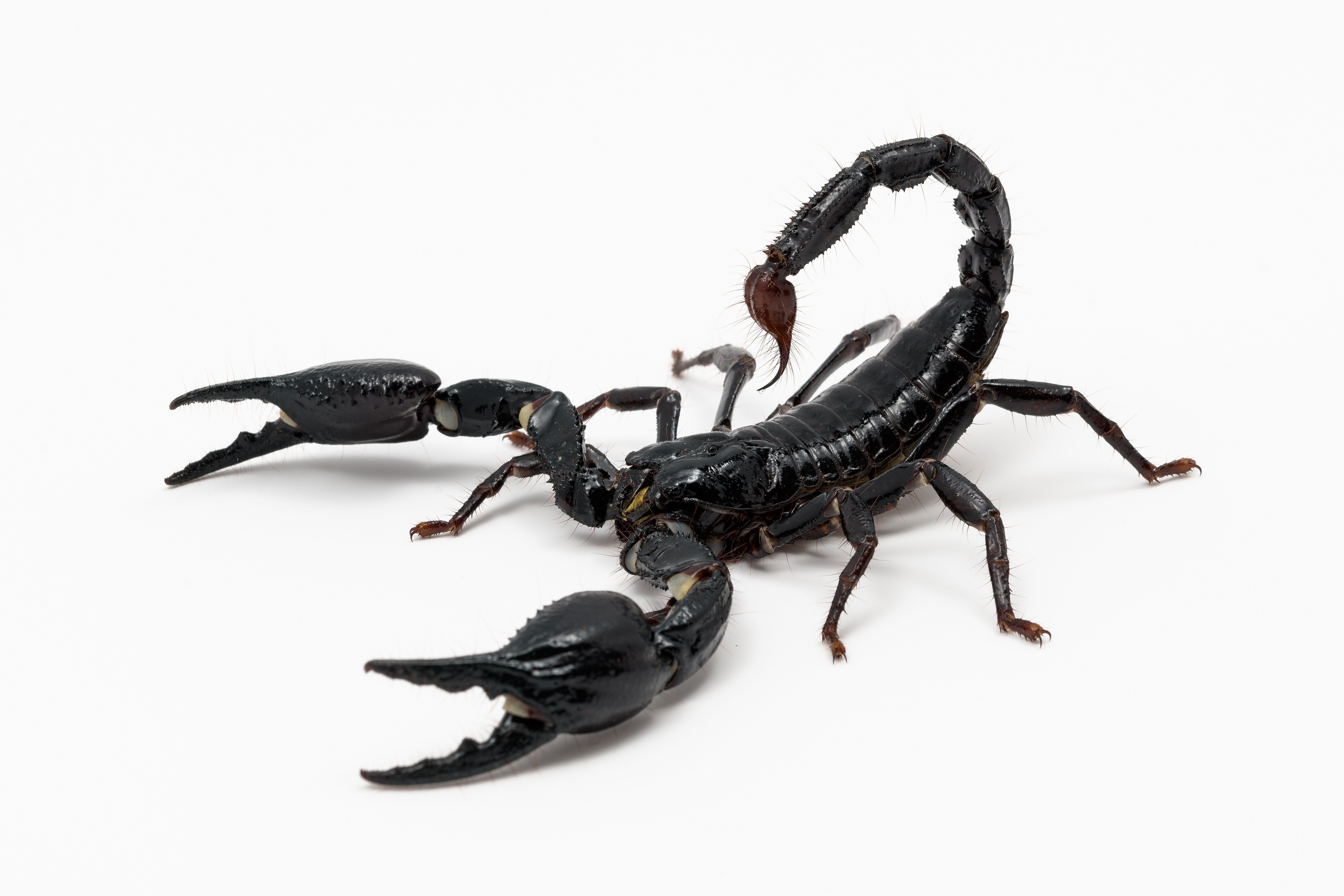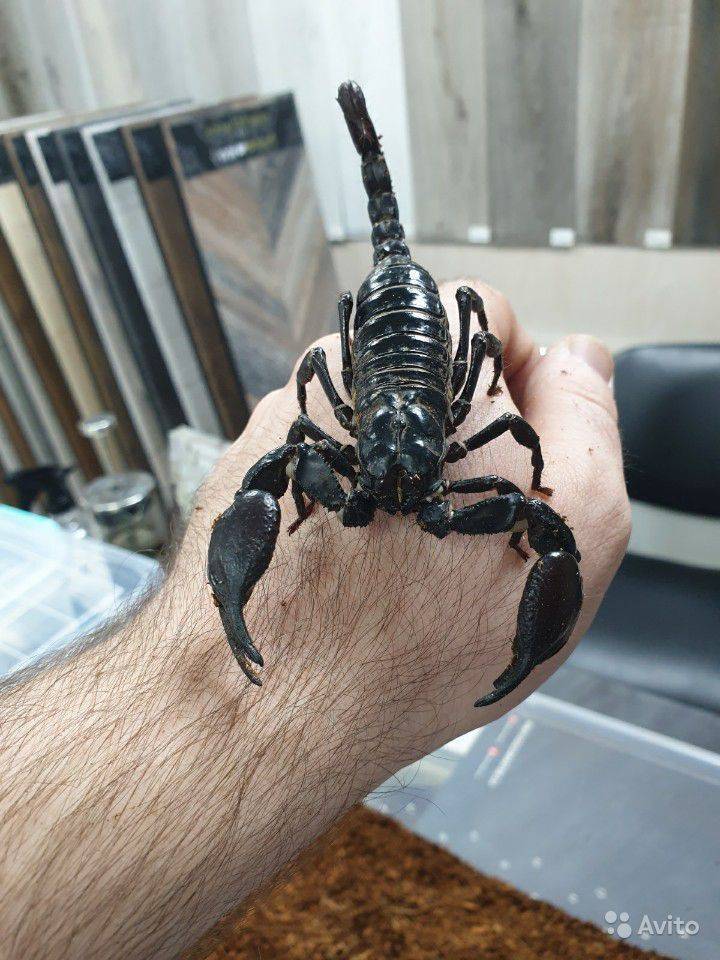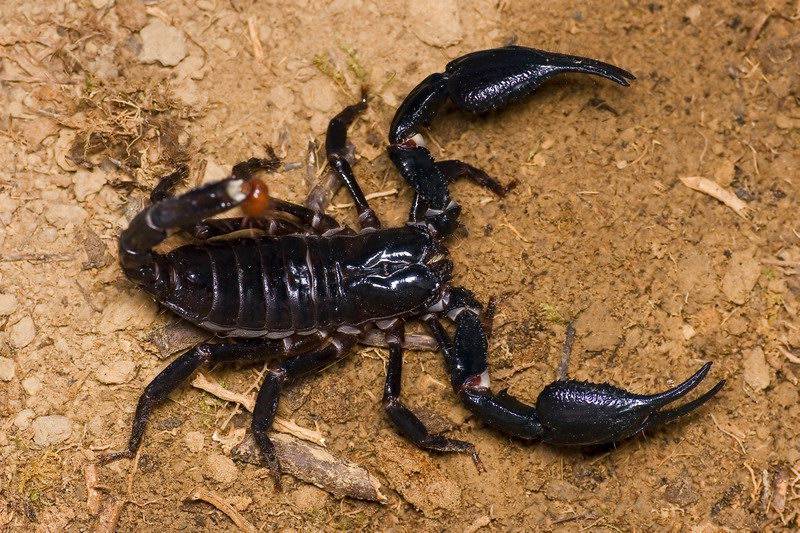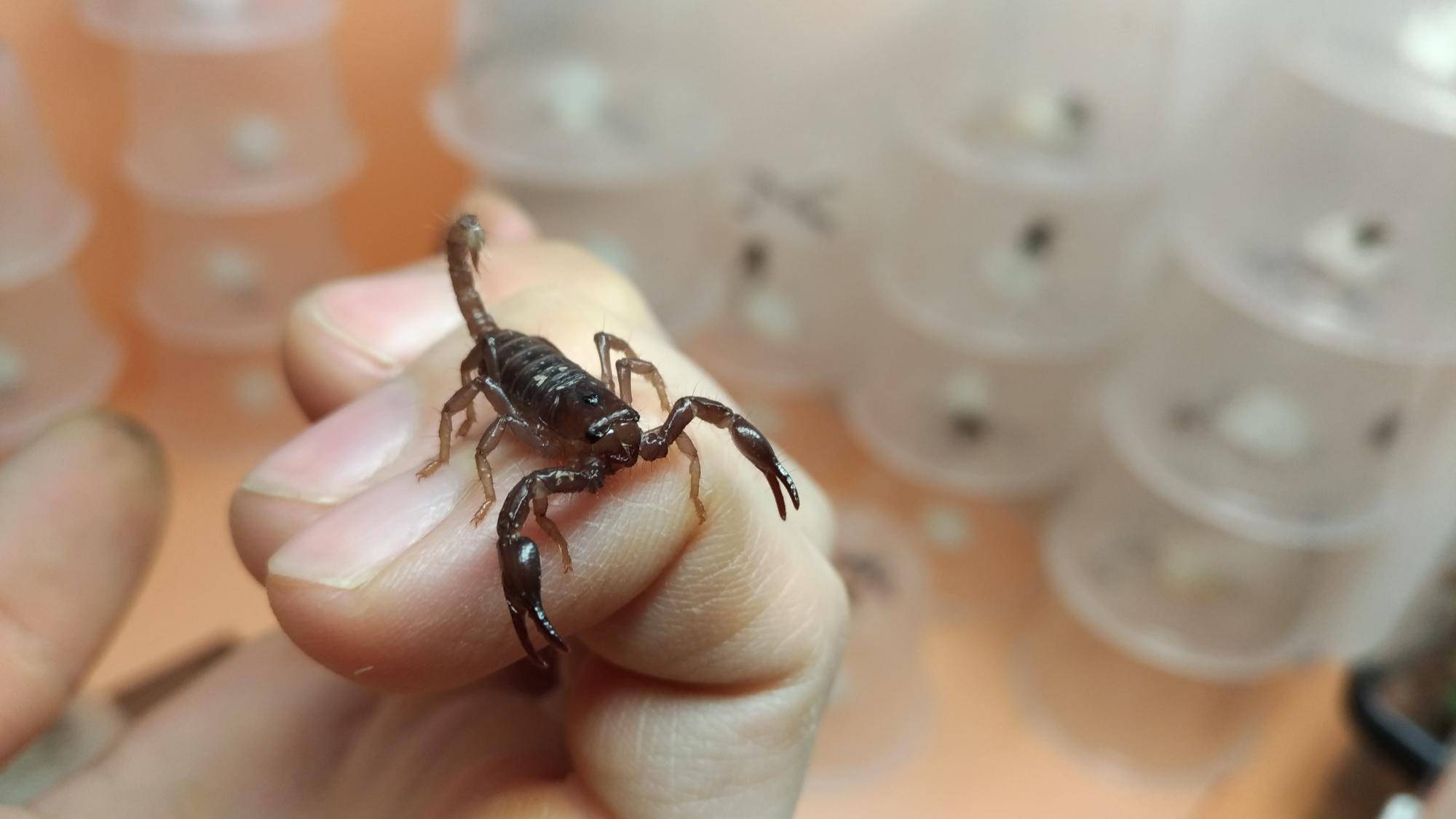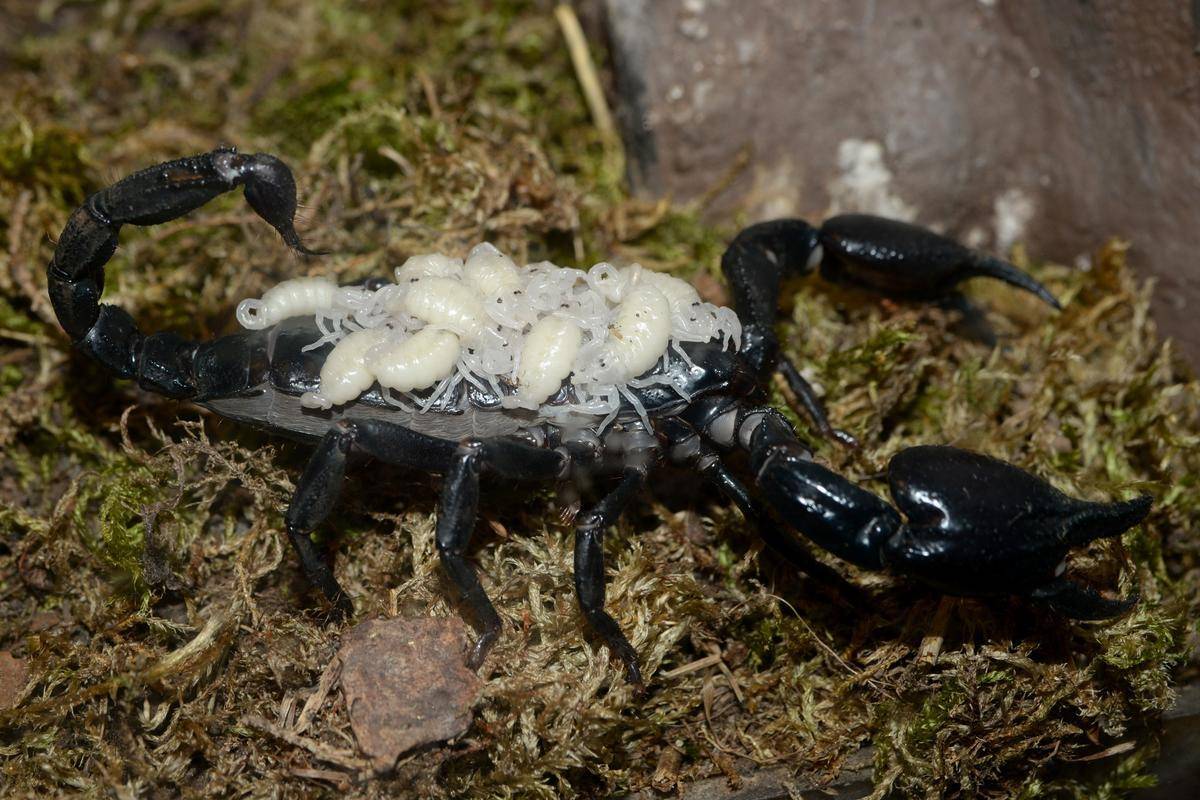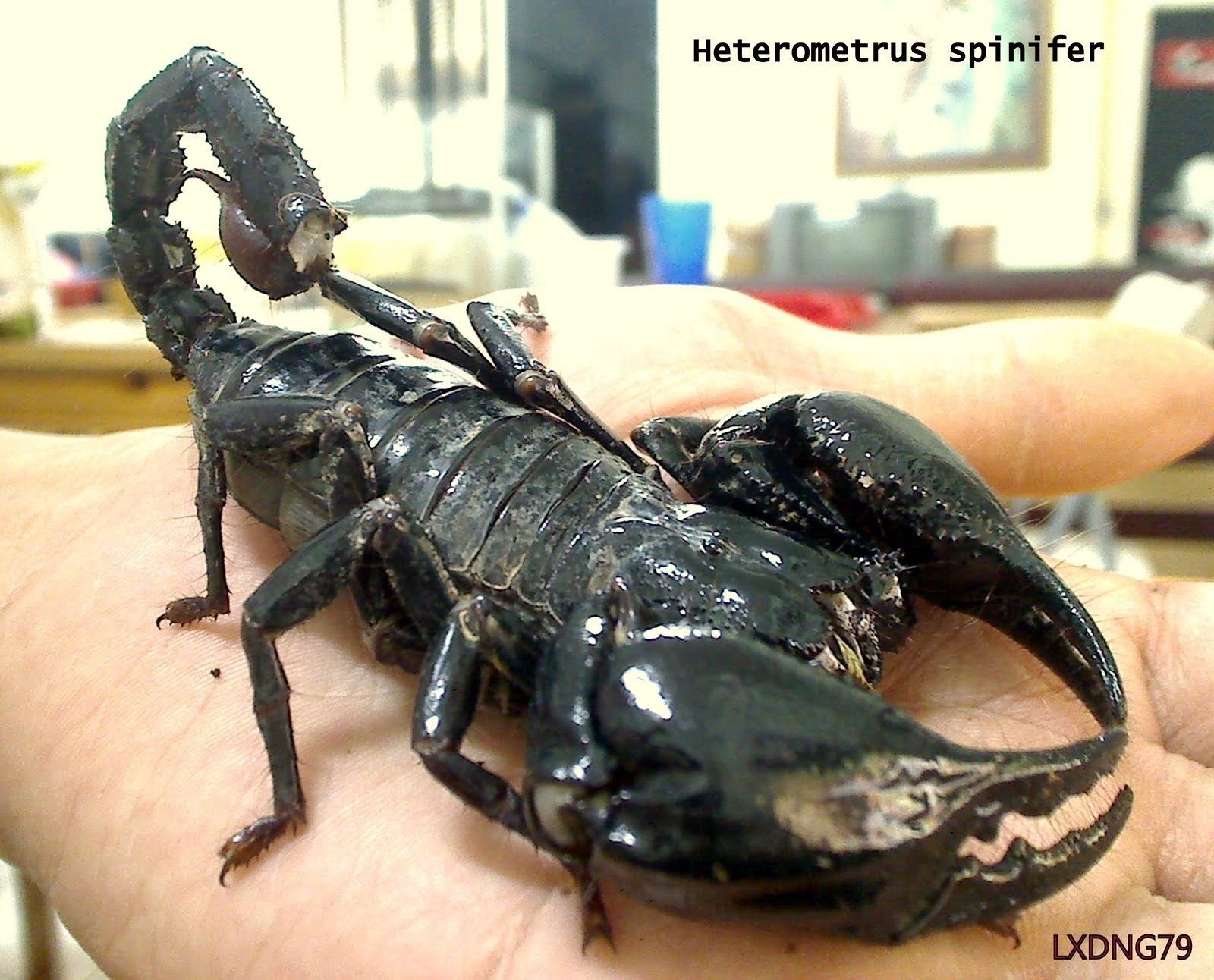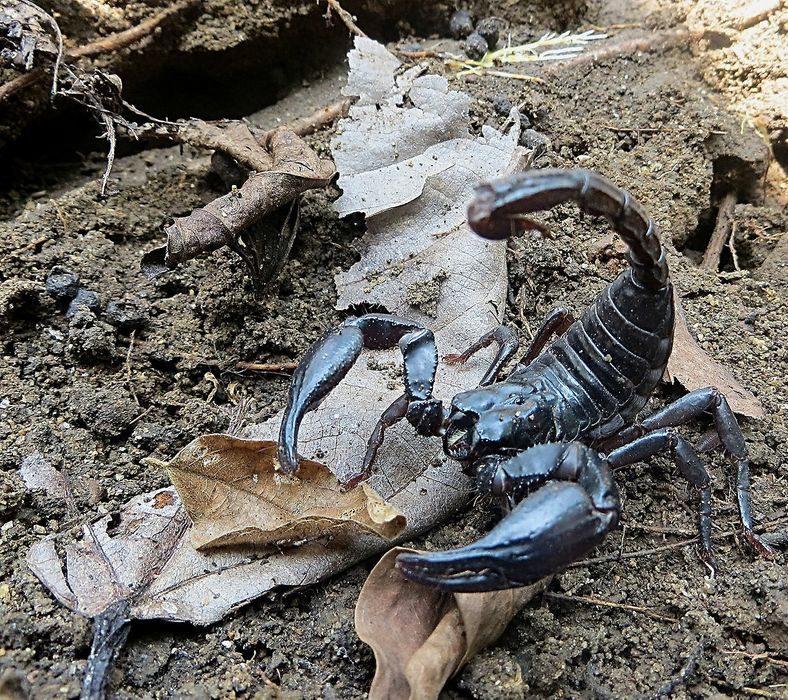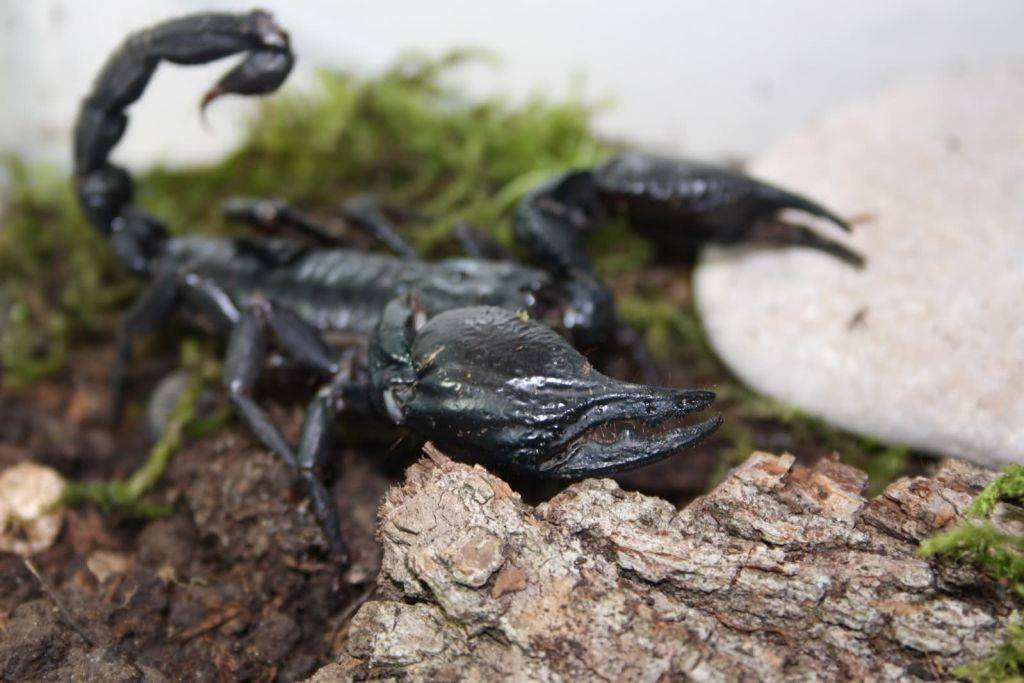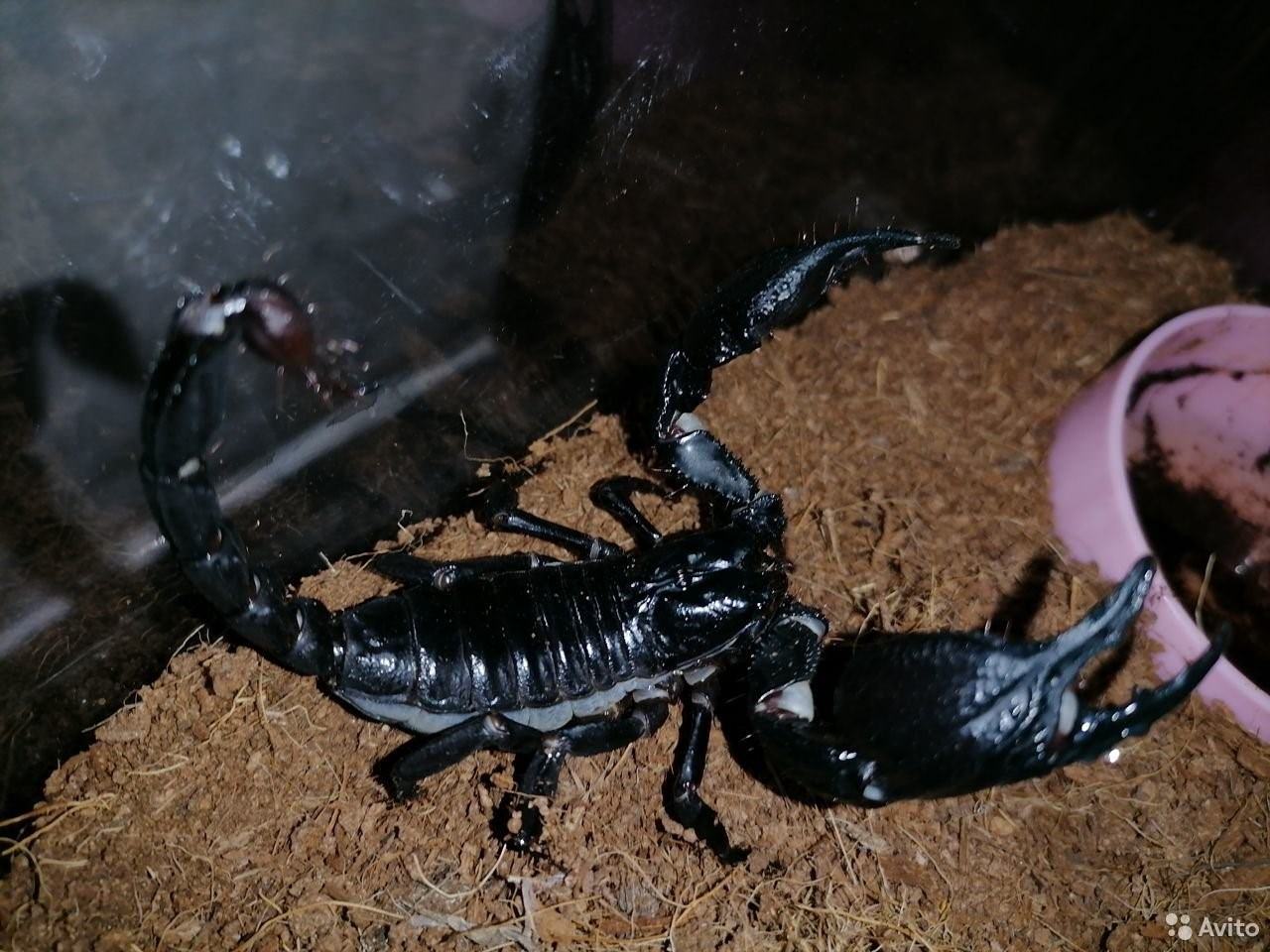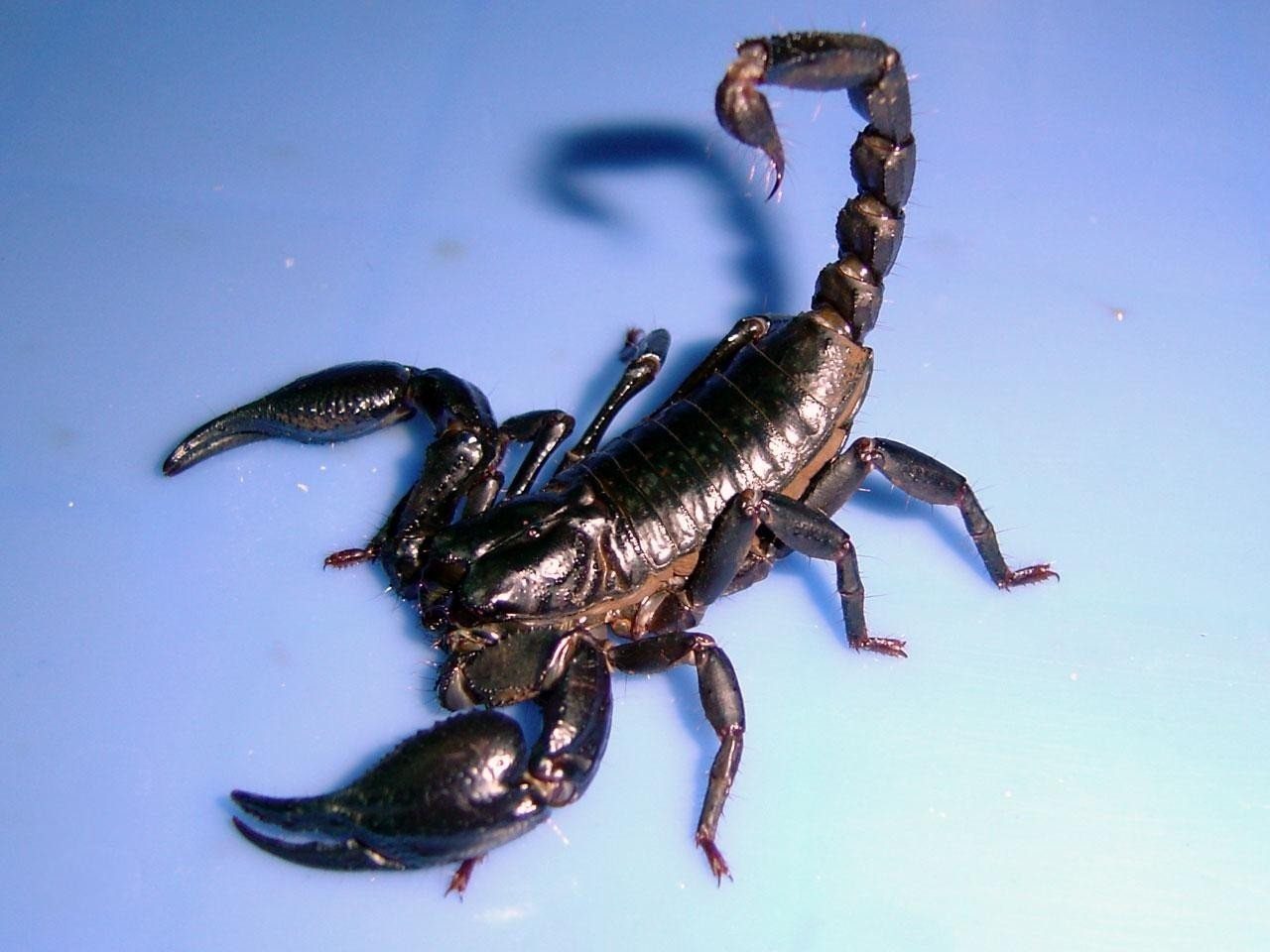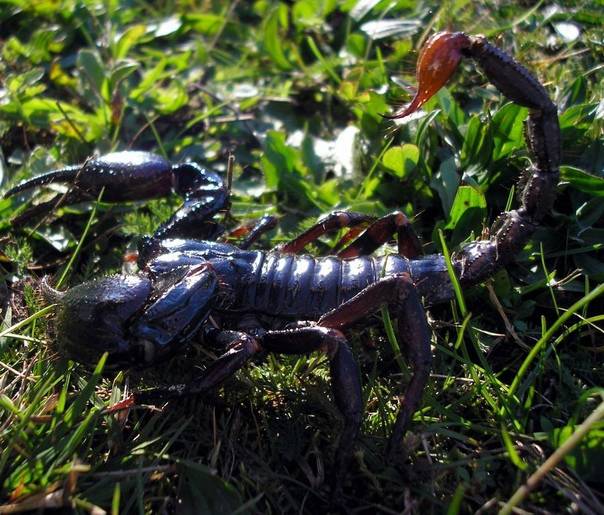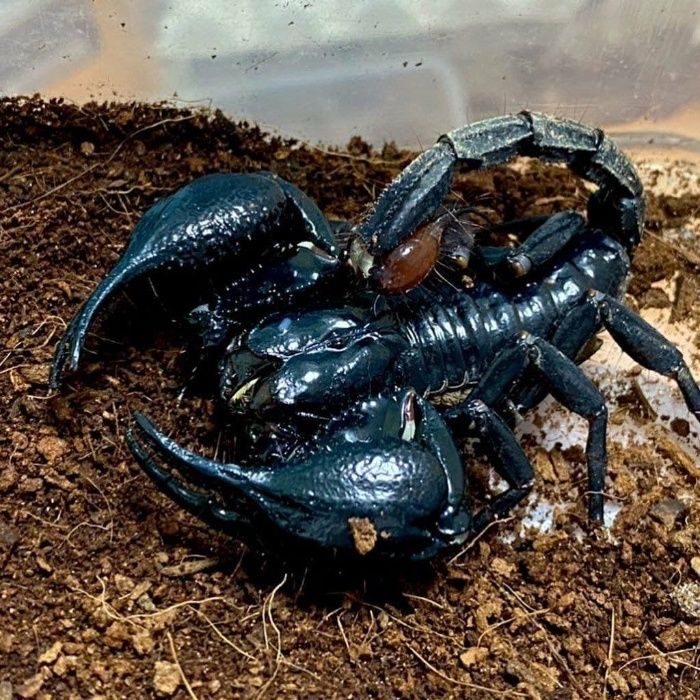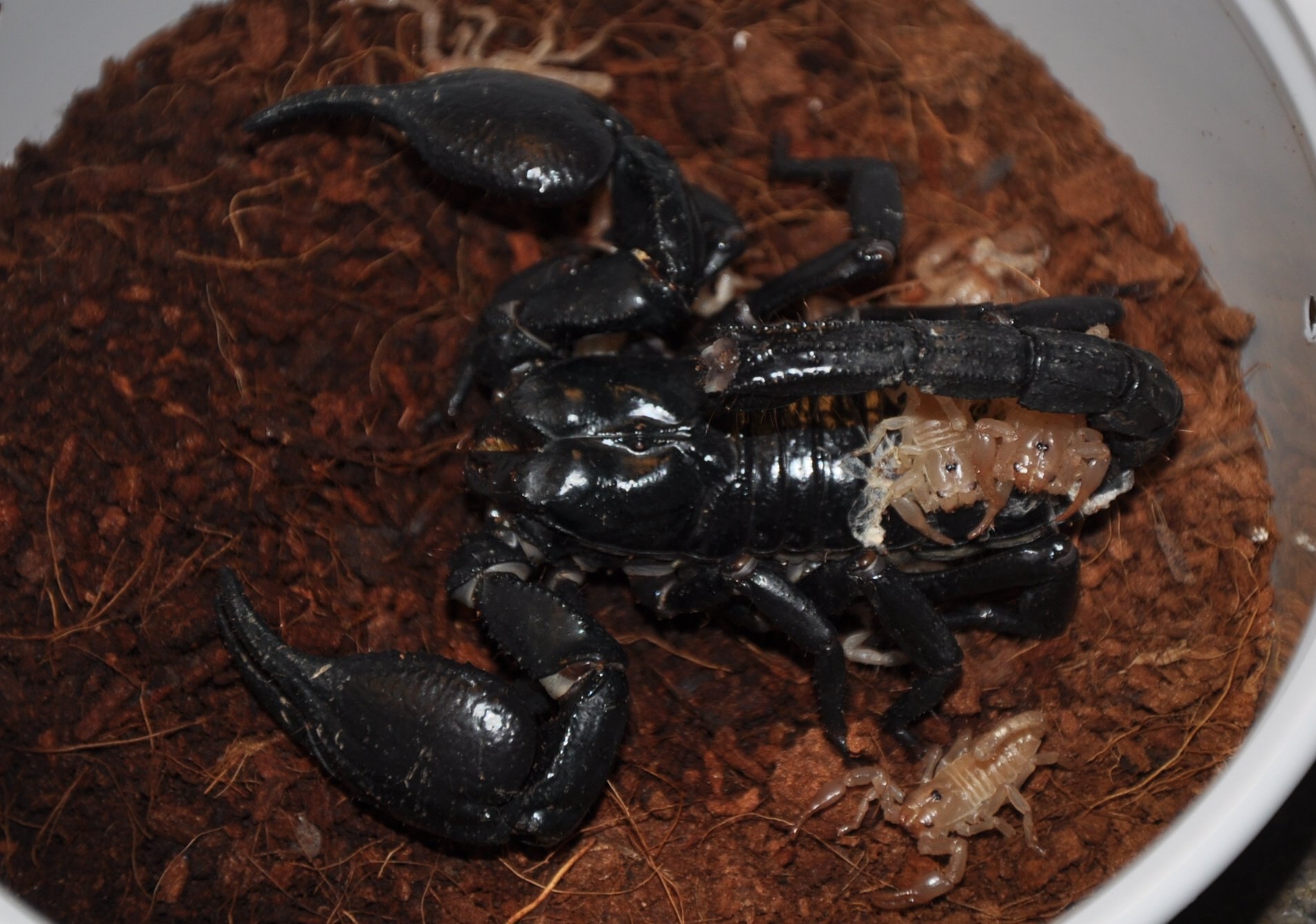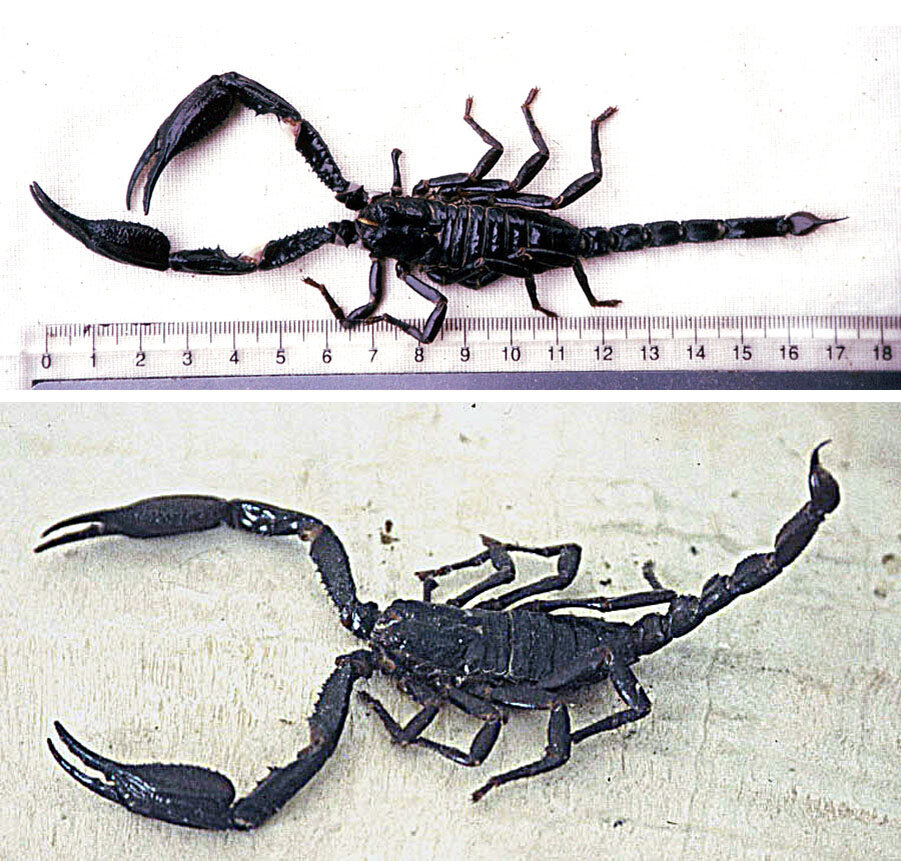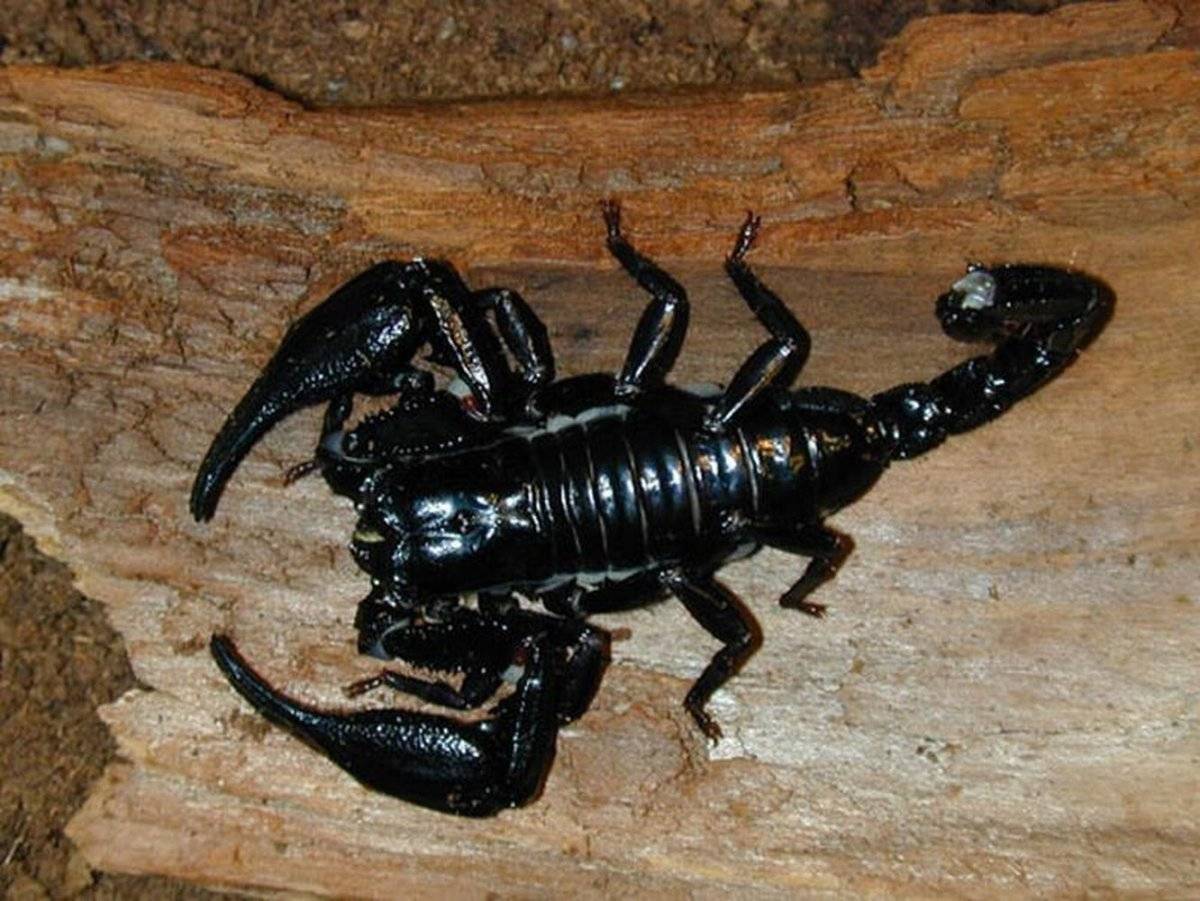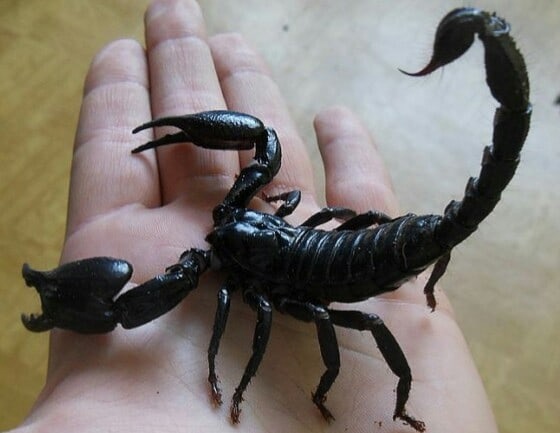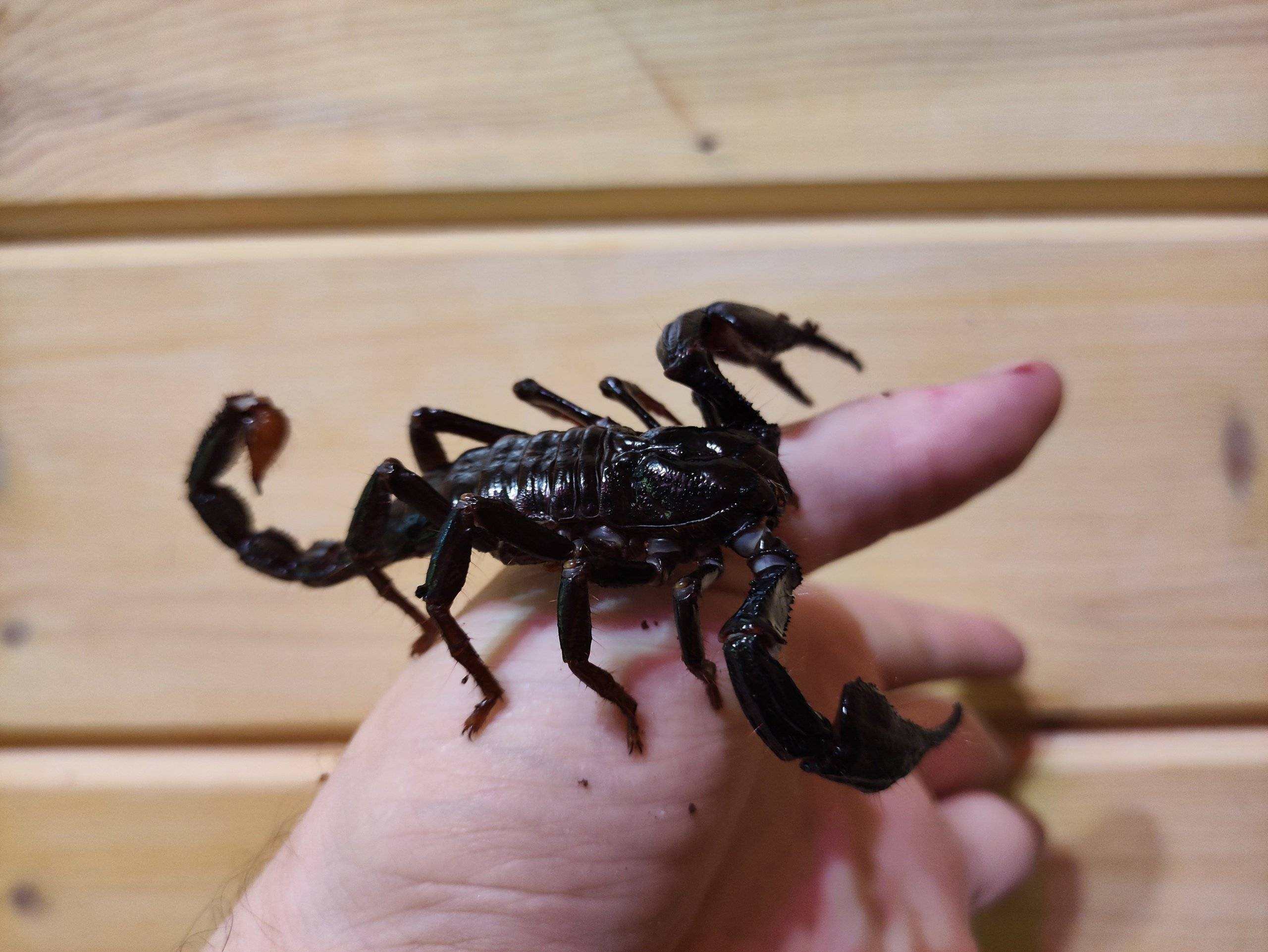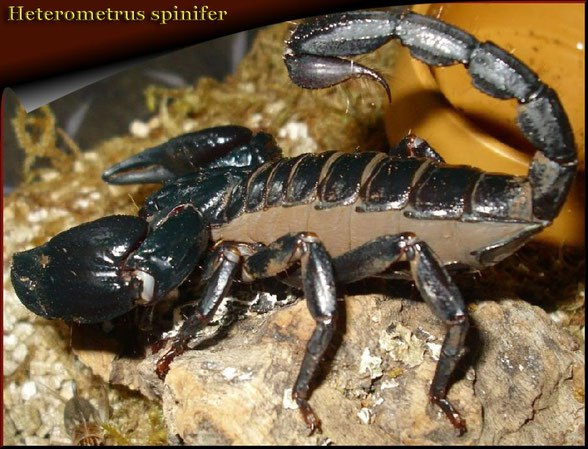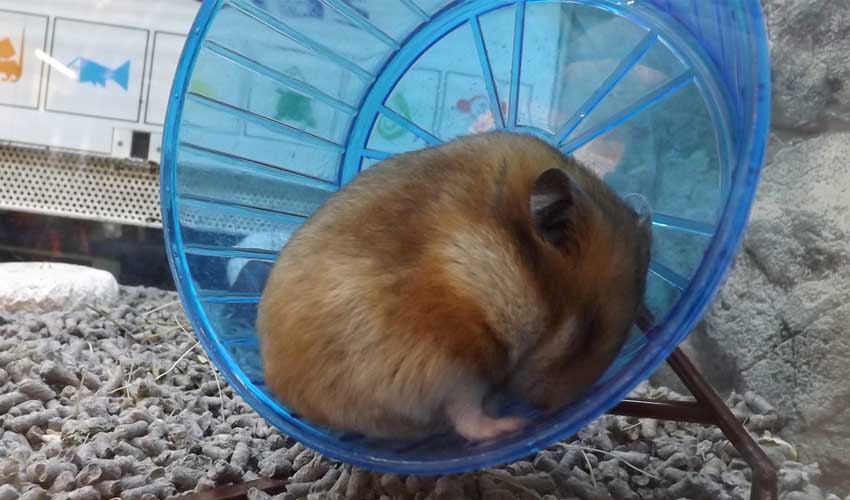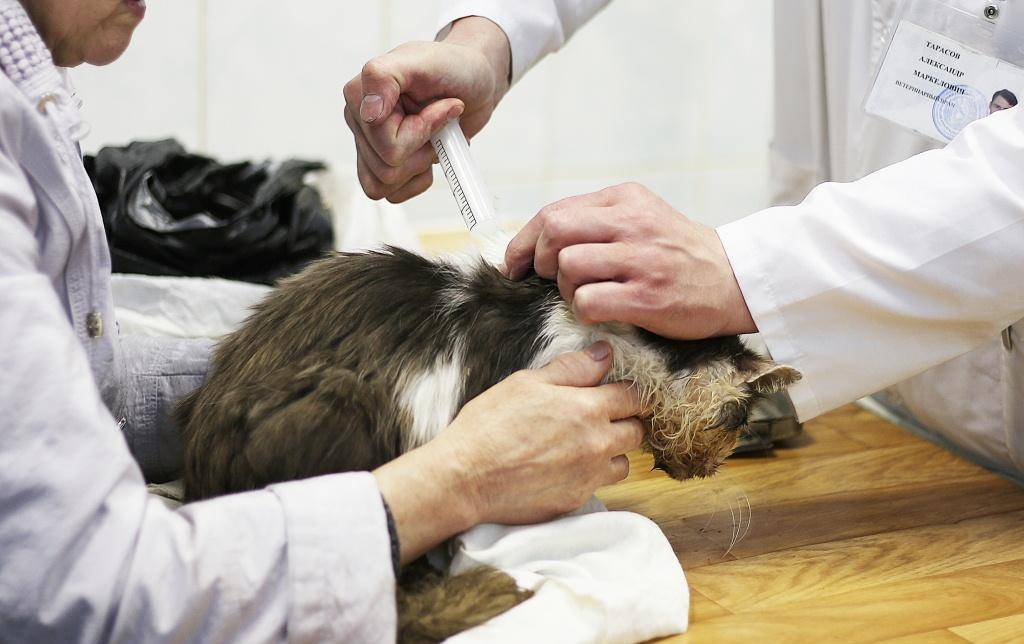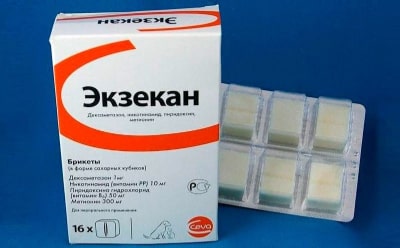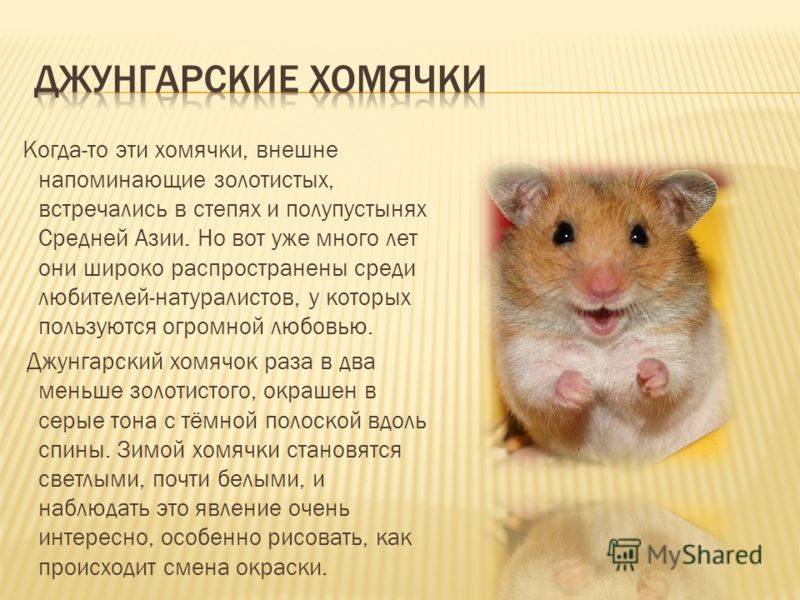Systematics
Color plate of the first description, from 1828, Buthus spinifer above, center
Initial description
It was first described in Latin by Christian Gottfried Ehrenberg in 1828 . Older literature also shows Friedrich Wilhelm Hemprich as the author , the full species name was therefore Hetrometrus spinifer ( Hemprich & Ehrenberg , 1872) . Hemprich had already died in 1825 on a joint research trip, Ehrenberg named him as the first author to honor his achievements as a researcher. The rules of the zoological nomenclature (biology) do not provide for this, so that Ehrenberg is now considered the sole author of the first description.
The date of publication of the first description is 1828, although the relevant volume of the work Symbolae physicae seu icones et descriptiones animalium evertebratorum sepositis insectis quae ex itinere per Africam borealem et Asiam occidentalem ( Symbolae physicae ) has the year of publication 1831 on the title page . The background to this is the practice at the time of bringing out printed works in individual deliveries that were only brought to the bookbinder after a volume was complete. In the case of Heterometrus spinifer , the color plate with the illustration of the species was delivered as early as 1828. This year is considered to be the year of the first description in the zoological nomenclature, because the board shows the species name as a caption, i.e. there is a clear connection between the illustration and the species. If the caption was missing or not clear, the year 1831 would apply, in which the text of the first description was published.
Type material
Ehrenberg based his first description on a subadult male collection specimen which had been collected by the Alexandrian doctor Morpurgo. Morpurgo had supported Hemprich and Ehrenberg financially and as a doctor during their expedition. This copy is in the Berlin Museum of Natural History .
Couzijn wrongly stated in his revision of the genus Heterometrus in 1981 that this holotype was probably lost during the Second World War. For this reason Couzijn designated a scorpion from the collection of the Naturalis Museum of Natural History in Leiden, with the indication of origin Kedah in Malaysia, as a neotype. When Kovařík revised it in 2004, the original holotype was available. Therefore, Kovařík declared the establishment of a neotype in accordance with the International Rules for Zoological Nomenclature invalid.
In addition, the Natural History Museum in London has a series of three adult males, two females and one juvenile scorpion with no indication of origin. These are probably the syntypes with the indications of origin Myanmar, Thailand and Singapore, which Reginald Innes Pocock described in 1900 as Palamnaeus oatesii . This species was synonymous with Heterometrus spinifer by Couzijn in 1981 .
etymology
In his first description of Heterometrus spinifer, Ehrenberg stated the following:
– Christian Gottfried Ehrenberg
The feature described is the pointed cusps on the insides of the patella of the pedipalps. The species name is derived from the Latin word spinus (German: thorn ) and the suffix -fer (German: bearing ), meaning thorn-bearer , but without reference to the poison sting .
Genera and synonyms
As a species of the genus Heterometrus , Heterometrus spinifer has been assigned to different genera since it was first described. This was the result of different views of the arachnologists about the validity of individual genres and their differentiation from one another. Heterometrus spinifer was placed in the genera and subgenus Buthus (Heterometrus) , Buthus , Scorpio (Buthus) , Heterometrus , Palamnaeus and most recently in 1981 by Couzijn in the subgenus Heterometrus (Heterometrus) . The subgenus Heterometrus and all other subgenera described by Couzijn were abolished in 2004 by František Kovařík in his revision of the genus Heterometrus .
- The following names have also been used as synonyms in the literature: Palamnaeus laevigatus Thorell , 1876 , Heterometrus longimanus Kraepelin , 1895 (partially) and Palamnaeus oatesii Pocock , 1900 .
Интересные факты о Гигантском Лесном Скорпионе
1. Гигантский лесной скорпион – самый крупный вид скорпионов
Gigantometrus swammerdami – самый крупный вид скорпионов во всем мире! Самые крупные представители этого вида могут достигать 23 сантиметров в длину. Это почти такого же размера, как кегля для боулинга!
Мало того, гигантский лесной скорпион всегда может весить почти 60 граммов. Хотя это может показаться не так уж много, он примерно такого же веса, как теннисный мяч, который к тому же тяжелее любого другого скорпиона в мире.
2. Он не полагается на яд, чтобы охотиться на добычу
Важно отметить, что, как и все другие виды скорпионов, гигантский лесной скорпион является ядовитым видом. Однако, хотя у них и есть этот яд, который они могут использовать по мере необходимости, на самом деле это не основной способ, с помощью которого они могут выследить свою впечатляющую добычу
Однако, хотя у них и есть этот яд, который они могут использовать по мере необходимости, на самом деле это не основной способ, с помощью которого они могут выследить свою впечатляющую добычу.
Вместо этого, подобно змеям-констрикторам, скорпионы раздавливают свою добычу своими мощными щипцами!
3. Они родственны паукам
Хотя научное название – Gigantometrus swammerdami, это лишь малая толика информации о гигантском лесном скорпионе. В частности, это отображает их род и разновидности.
Однако, когда вы смотрите только на эту информацию, может быть легко пропустить некоторые удивительные способы связи разных животных!
Например, знаете ли вы, что скорпионы на самом деле родственны паукам?
Все верно, и пауки, и скорпионы относятся к классу Arachnida. Сюда также входят некоторые другие удивительные виды, такие как клещи.
4. Гигантский лесной скорпион относится к двум разным видам
Гигантский лесной скорпион – прекрасный пример того, почему важны научные названия. На самом деле существует два вида, которые известны как гигантский лесной скорпион. Первый – Gigantometrus swammerdami, о котором вы сейчас читаете.
Другой вид, известный под этим общим названием, – Heterometrus spinifer. Другие распространенные названия H. spinifer включают азиатского лесного скорпиона и гигантского синего скорпиона.
Как вы можете судить по их разным родам, что является первым словом в их научном названии, эти два вида не являются тесно связанными по сравнению с другими, более похожими видами скорпионов.
Однако они действительно имеют схожий внешний вид, и оба расположены в южных регионах Азии.
В результате важно уметь отличать эти виды друг от друга, и именно здесь может сыграть роль наличие научных названий
5. Это одиночные животные
Вне брачного сезона гигантские лесные скорпионы ведут одиночный образ жизни. Это означает, что они будут проводить свое время в одиночестве, будь то отдых или охота.
Брачный сезон у Gigantometrus swammerdami приходится на летние месяцы. За это время больше особей-отшельников покинут свои норы и соберутся вместе. У некоторых видов скорпионов есть брачный танец, в то время как другие могут жалить и даже пожирать друг друга.
Что самое удивительное в скорпионах, так это то, что они рождаются живыми, как млекопитающие! Они так называемые яйцекладущие, что означает, что яйцеклетки вылупляются внутри матери до рождения.

6. Их можно найти в домах других животных
Когда дело доходит до определения местонахождения следующего гигантского лесного скорпиона, ученые точно выяснили, где искать. Как выясняется, гигантским лесным скорпионам нравится жить в заброшенных норах других животных.
Ученые находили их в зарубках на деревьях, разрушающихся термитниках и даже в старых крысиных норах или крабьих норах!
7. У них гребенчатые зубчики, называемые пектинами
Гигантский лесной скорпион имеет от 16 до 20 маленьких гребнеобразных зубов, известных как пектины.
Как правило, пектиновые зубы используются для ухода за шерстью. Однако они также могут быть использованы для получения других преимуществ в мире природы, от фильтрации до помощи животному в ощущении окружающей среды.
Это то, для чего многие скорпионы используют свои пектины: для придания вкуса. Их зубы устроены таким образом, чтобы улавливать и транслировать химические и физические раздражители в мозг, помогая им лучше понимать окружающую среду.

8. Мы хорошо понимаем их яд
Хотя о Gigantometrus swammerdami известно не так много, мы хорошо понимаем их яд. Это легкий паралитик у мелких видов.
Однако, поскольку они эволюционировали, чтобы полагаться на свои щипцы для охоты, их яд не смертелен для большинства людей.
Description of Asian Forest Scorpions
 photo by Timur Zinov
photo by Timur Zinov
These scorpions grow pretty big. Fully grown adult Asian Forest scorpions can reach up to an impressive 6 – 8 inches (15 – 20 cm). However, it’s quite rare to find one of that size.
Generally, the average size of adult scorpions is often about 4 – 6 inches (10 – 15 cm) long.
The coloration is mostly dark. However, depending on the species, it may also vary from light brown to almost black.
Interesting fact: If you put them on the sunlight their body will have some kind of greenish bluish tint to it.
They have a well-developed and very powerful pair of pincers (pedipalps) which they use to catch prey.
Asian Forest scorpions have very bad eyesight. Instead, they rely on sensory organs – little tiny hairs on their body, pincers, tails, and legs.
Related article:
Scorpions External Anatomy
Уход в неволе Heterometrus longimanus
Пока контролируются параметры окружающей среды в террариуме и соблюдаются все спецификации, позаботиться об образце Heterometrus longimanus в неволе это очень просто.
Каким должен быть террариум?
Heterometrus longimanus он может достигать размеров до 13 сантиметров и прожить в неволе около восьми лет. Поэтому, террариум никогда не должен быть меньше 20 литров, около 30x20x20 см в длину, ширину и высоту.
Быть наземным животным, которое не копает и не чешется, обязательно, чтобы террариум был длиннее, чем высокий. На него будет уложено около 10 сантиметров субстрата из компоста без торфа, который легко найти в специализированных магазинах.
В идеале на вышеупомянутый субстрат следует положить хороший слой другого типа субстрата: например, стружку коры орхидеи. Эти материалы несколько сложнее получить, но они также доступны в Интернете.
Также должны быть включены укрытия, такие как камни или стволы деревьев. Эти животные очень любят исследовать, так удобно усердно менять декор внутри террариума, не слишком напрягая скорпиона.
Параметры окружающей среды
Будучи оригинальным из тропических лесов, наиболее важными параметрами, которые необходимо учитывать, являются температура и влажность. Что касается последнего, то и исчерпывающий контроль не нужен.
Каждый день террариум поливают небольшим количеством воды, чтобы субстрат был увлажнен, но никогда не слишком много. При появлении грибка на поверхности необходимо удалить весь субстрат и поставить новый.
Температура должна оставаться в оптимальном диапазоне от 24 до 32ºC. Лучше всего использовать тепловые лампы или излучающие шары, но только в одной части комнаты. Таким образом, животное может контролировать температуру своего тела, изменяя свое поведение, чтобы при необходимости помещать его ближе или дальше от источника тепла.
Скорпион диета Heterometrus longimanus
Heterometrus longimanus это плотоядное животное, которое питается исключительно насекомыми такие как сверчки, тараканы, черви и личинки насекомых. Если скорпион еще не достиг взрослого размера или только вылупился, его следует кормить булавочными сверчками или мухами дрозофилы.
Вязка азиатского лесного скорпиона
Поднимать Heterometrus longimanus в неволе это не проблема, пока самец и самка не решают убить друг друга вместо спаривания. Если вы хотите, чтобы ваши скорпионы размножались, вам придется подготовить почву.
В отдельном террариуме на субстрат кладут плоский камень. На этой сцене пара исполнит любопытный танец ухаживания. После приготовления вводят обоих скорпионов.
Вам обоим потребуется несколько дней, чтобы довериться друг другу, а самка была готова к совокуплению. Как только это произойдет, начнется танец на камне, предшествующий совокуплению.
Скорпион-самец помещает свой сперматофор на камень, а самка вводит его в генитальное отверстие. Как только это произойдет, самец скорпиона будет удален, а самка будет оставаться максимально спокойной на протяжении всего процесса инкубации яйца. Эти животные яйцеживородящие.
Инкубация длится 9 долгих месяцев, поэтому нужно запастись терпением. После рождения детеныши забираются на спину матери и остаются там до первой линьки. В этот период самка не ест.
Когда птенцы спускаются, лучше индивидуализировать их в других вольерах и мать снова будет нормально кормить. У каждой самки около 20 детенышей, поэтому нужно хорошо подумать, что с ними делать потом.
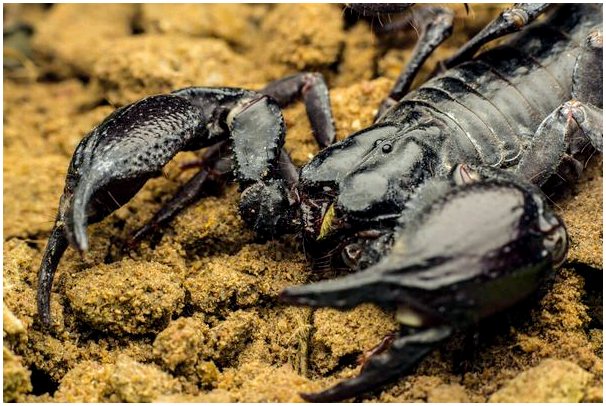
References:
- Gwee, Matthew CE, Selvanayagam Nirthanan, Hoon‐Eng Khoo, Ponnampalam Gopalakrishnakone, R. Manjunatha Kini, and Li‐Sam Cheah. “Autonomic effects of some scorpion venoms and toxins.” Clinical and Experimental Pharmacology and Physiology 29, no. 9 (2002): 795-801.
- Casper, Gary S. “Prey capture and stinging behavior in the emperor scorpion, Pandinus imperator (Koch)(Scorpiones, Scorpionidae).” Journal of Arachnology (1985): 277-283.
- Kovařík, František. “A review of the genus Heterometrus Ehrenberg, 1828, with descriptions of seven new species (Scorpiones, Scorpionidae).” Euscorpius 2004, no. 15 (2004): 1-60.
- Izzat-Husna, M., Syed A. Rizal, and B. A. Amirrudin. “Notes on scorpion fauna in Kuala Lompat, Krau Wildlife Reserve, Pahang, Malaysia.” Journal of Wildlife and Parks 28 (2014): 121-129.
- Tobler, Irene, and Jaqueline Stalder. “Rest in the scorpion—a sleep-like state?.” Journal of Comparative Physiology A 163, no. 2 (1988): 227-235.
- Chiariello, Thiago M. “Veterinary care of scorpions.” Journal of Exotic Pet Medicine 26, no. 2 (2017): 114-122.
- Gomes, A., and A. Gomes. “Scorpion venom research around the world: Heterometrus Species.” Scorpion Venoms: Springer(2015): 351-67.
- Prendini L, Loria SF. Systematic revision of the Asian Forest Scorpions (Heterometrinae simon, 1879), revised suprageneric classification of Scorpionidae latreille, 1802, and revalidation of Rugodentidae Bastawade et al., 2005.
- Tang, V. 2022 . A standardized list of scorpion names in Chinese, with an etymological approach. Euscorpius, No. 350: 1-91.
- Systematics and biogeography of the family Scorpionidae (Chelicerata : Scorpiones), with a discussion on phylogenetic methods. Invertebrate Systematics, 2003
- Jiao, Guo-Bin, and Ming-Sheng Zhu. “Courtship and mating in Heterometrus petersii (Thorell, 1876) (Scorpiones: Scorpionidae).” Euscorpius2009, no. 84 (2009): 1-5.
- Jiao, G., & Zhu, M. 2009 . Prey capture behavior in Heterometrus petersii (Thorell, 1876) (Scorpiones: Scorpionidae). Euscorpius, No. 80: 1-5.
Malaysian forest scorpion habitat
Malaysian forest scorpion collony
The Malaysian forest Scorpion should be provided with an enclosure of atleast 6 gallons in volume due to it’s sheer size and bulk. Vertical room is not really a priority as they prefer to stay at ground level. Floor space is important to allow places for your scorpion to explore, and an improvised shelter such as a hollow log or a decorative cave used in aquariums should also be included.
Substrates for Malaysian forest scorpions
Heterometrus are forest species that come from Africa and Asia and require warm, humid conditions. A deep layer (6-7cm) of peat-free compost should be placed in the terrarium, this can be covered with orchid bark chippings. The substrate should be sprayed with water every day or so but never to a degree that it becomes very wet. Care should be taken that the substrate does not become mouldy or covered in fungus.
Temperature for Malaysian forest scorpions
Temperature and humidity equipment
This species requires temperature ranges of between 24-32°C (75-90°F). A temperature gradient is important to allow the scorpion to regulate their body temperature as needed. The easiest way to provide the gradient is by using a heating mat designed for use under reptile tanks. This should be placed under no more than about 1/3 of the tank, so your pet can move from warmer to cooler temperatures if desired. However, to ensure the temperatures are being provided you should monitor them by using accurate thermometers in a few locations within the enclosure.
Humidity for Malaysian forest scorpions
They should be kept in a humid environment of between 60-80%, and this can be achieved by providing a shallow water dish and misting regularly as necessary. To successfully maintain the desired humidity conditions for your Malaysian forest Scorpion you are going to need a hygrometer. A hygrometer is a device used to measure relative humidity within the enclosure.
References
- Animal-World Resources: Reptiles, Amphibians, and Land Invertebrates
- Russ Gurley, Tarantulas and Scorpions in Captivity, Living Art Pub, Serpent’s Tale NHBD , 2005
- Philip Brownell, Gary Polis, Scorpion Biology and Research,.Oxford University Press, USA 2001
- Philippe de Vosjoli, Arachnomannia, General Care and Maintenance of Tarantulas & Scorpion, Advanced Vivarium Systems, 1991
- V. Hull-Williams, “How to Keep Scorpions”, Fitzgerald Publishing, London, UK
- Gary A. Polis, Biology of Scorpions, Stanford University Press 1990
- J. L. Cloudsley-Thompson, Spiders, Scorpions, Centipedes, and Mites,.Pergamon Press 1968
- Hugh L Keegan, Scorpions of medical importance,.University Press of Mississippi 1980
Feeding Problems with Asian Forest Scorpions
Some hobbyists complain that their scorpions stopped eating for weeks. This often happens right after purchase. Some potential reasons include:
- Shipment stress. Give them time to adapt to their new home.
- Preparation for a molt. Changes in their eating habits change drastically before molting. You will see a sharp decrease in appetite. They may start eating less and eventually stop eating altogether.
- Not hungry. Scorpions have a very low metabolism and can live without food for months.
- Low temperature. When the temperature drops, Asian forest scorpions become very lethargic.
However, in some cases, we can have the opposite problem – a scorpion becomes so fat that it looks like its body squeezing out of its exoskeleton.
- Diet control. Check its diet. You are giving them way too much.
- Gravid female. Make sure that your scorpion is not a gravid female. In this case, you will also see a little bit of white space between each carapaces and the pleural membrane will be exposed. This is normal.
Features:
- Diet Type: Carnivore
- Food Preference: Alive prey.
- Feeding Frequency: 1 time a week (for adults) and 2 times a week (for babies)
| Asian forest scorpion usually eats the prey alive. So, if you are a sensitive person, you should not keep them as a pet. |
Related article:
What Do Pet Scorpions Eat and How to Feed Them
Diseases: Ailments/Treatments
Scorpions are generally quite hardy and adaptable if they are provided with the right environment. A few signs that may indicate that your pet is not acting or feeling normal are a loss of appetite, acting listless or sluggish, having an overly swollen stomach, and missing or deformed limbs. Another problem can be an infestation of mites.
- MoltingOne of the most common reasons for the death in scorpions is the molt. The scorpion has a tough outer covering, a cuticle, that forms a rigid exoskeleton. All scorpions must shed their old exoskeleton and secrete a new one in order to grow, this is called the molt. Scorpions will molt from 6 to 10 times during their lifetime. This molting process takes a lot of energy and they are very vulnerable for a couple of days after the molt until their new skin hardensFor about 24 hours prior to molting it is not unusual for a scorpion to get quite sluggish.A difficult molt can result in lost or deformed limbs, or death. This is thought to be related to humidity levels. There can be either too much humidity or too little, depending on the species. In captivity a lot of immature scorpions die during the molting process.
- Other ProblemsThough many scorpions can go for long periods of time without eating, overfeeding can cause an overly swollen stomach as well as the loss of appetite, and even death. The stomach can be slightly swollen from regular eating, and this is not a problem.Another problem can be an infestation of Mites. Uneaten food can attract mites, which are very dangerous and stressful to scorpions. Be sure to remove old food.
Handling Asian Forest Scorpions
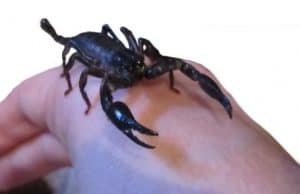 Asian forest scorpions are venomous invertebrates with powerful pair of claws, so you need to handle your scorpions with utmost care. They are not pets you can play with!
Asian forest scorpions are venomous invertebrates with powerful pair of claws, so you need to handle your scorpions with utmost care. They are not pets you can play with!
Make sure children do not provoke the scorpion. It is against ethics and provoking the scorpion has its consequences.
Do not take them out just because you want to. You should really handle him as little as possible. They do not benefit from being handled and get stressed very easily.
Nonetheless, if you want/need to take them, it will be better to use rubber gloves:
- put your hand in front of the scorpion,
- nudge it from any side with a brush (pen, etc.),
- the scorpions will turn around to face the ‘threat’,
- nudge and slightly push it until it will back up onto your hand.
- Asian forest scorpions may behave defensively but they will not attack once they are in your hand.
- DO NOT press them down, they hate it!
Asian forest scorpions are more likely to pinch you than sting you. They can give a nasty bite and even break the skin of a human. As a result, you can flick your hand instinctively and your pet will go flying somewhere.
Asian forest scorpions can get hurt easily, even with their hard shells.
| Some people claim that their scorpions can recognize them and eventually become docile once they know food comes from you. Personally, I do not think so. Scorpions are not very smart animals, they, generally, operate on their instinctual nature. They do not understand and cannot learn, because they do not have long-term memory, – this is just beyond their abilities and nervous system. |
description
Heterometrus spinifer is a 100 to 135 millimeter long scorpion; adults have a uniform black body color. Only the scissors and the telson can be reddish-brown. Juvenile scorpions have a reddish-brown basic color with a yellow telson. The chelae are slightly lobe-shaped, with a length to width ratio of about 2.4 to 2.6 to 1 in adults. Their upper side is mostly smooth, with suggested keels that form a network pattern. The femora and patella of the pedipalps show no sexual dimorphism . The pedipalps have a thorn-shaped elevation on the inside of the patella. The carapace has a smooth surface with granulated edges. The combs of the comb organ have 15 to 19 teeth in both sexes. The telson is hairy and elongated, with a poisonous bladder longer than the venomous sting .
Breeding Malaysian forest scorpions
A pair of Malaysian forest scorpions mating
Heterometrus is a fairly easy genus to breed in captivity and wild caught females are often gravid. Prepare a habitat able to house two scorpions for at least 1 week, providing a flat surface for your scorpions’ courtship. This can be a rock, slate tile or broken crockery. Introduce the male and female scorpion in the enclosure and allow them to settle. It may take some time however mating will occur when the male and female scorpion are both ready; a courtship dance will take place between the mating pair before the male scorpion locks his chelae with the female scorpion’s chelae and leads the female with rhythmic manoeuvres. It may seem as if the scorpions are fighting; mating involves them grasping each other’s pincers and moving back and forth.
Malaysian forest scorpion mating dance
Scorpion spermatophore
During the mating dance the male scorpion will deposit his spermatophore on the provided flat surface. He will then manoeuvre the female scorpion over it so she can take it into her genital opening. Once you have noticed that the female has grown larger due to pregnancy is a good idea to remove the male scorpion and place him into another enclosure. Keeping your pregnant female scorpion in her own, adequately maintained tank ensures minimal disturbance during pregnancy and birthing. Stress can severely upset scorpion pregnancies and can even result in cannibalism when the offspring are born.
Malaysian forest scorpion birthing
Malaysian forest scorplings
Birth takes place after around 9 months for most scorpions; however this can be affected by several factors such as species, temperature and feeding. It is important to be patient and not stress out the female scorpion during this period but to keep a look out for birthing. Newly birthed, scorpions are almost colourless and will quickly climb onto their mothers’ back. Often the female will not feed until the young have moulted into 2nd instar. It will take about a week or two, depending on temperature for the 1st instar to moult. At this time it is most important to maintain the humidity, through misting and keeping the substrate moist.
Once the scorplings moult into 2nd instar and leave the mother’s back you can separate the babies from the adults, creating a similar habitat for them as for the adults. Raising the young in the adult tank may deal no problems however it is still possible that they will be cannibalised by the larger scorpions.
After the young have moved on, the mother scorpion will start to feed again so begin to offer her plenty of food in order to replenish herself and regain lost weight.
Raising Malaysian forest scorplings
Malaysian forest scorplings
After the young moult and leave the mother you can separate them into smaller enclosures. You can keep the young of Heterometrus together without problems as they are not the cannibalistic type as many Buthids. Provide the essential deep moist substrate, large shallow water dish hiding places such as cork bark or up turned plant pot. The scorplings will now be hungry so begin to offer them something to eat such as pinhead crickets or sliced up adults crickets, and other small insects.


